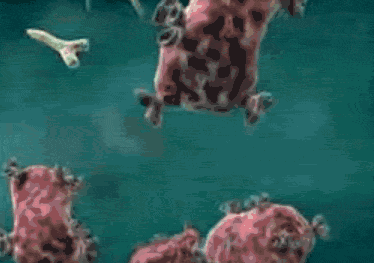White blood cells
and immunity continued.
There are many different types of lymphocytes but we will discuss two, the "T" and the "B" lymphocytes. The T lymphocyte leaves the lymph node and actually travels to the region where foreign matter is and attacks it. The B lymphocyte on the other hand stays in the lymph node taking part in the process of producing antibodies that disable the pathogen.
You see all pathogens have special proteins, we generally term, antigens, on the exterior of their membranes. These proteins have specific shapes that are unique to each pathogen. Both the B and T lymphocytes produce proteins, called antibodies, that match exactly the shape of the antigen molecule. Once the antigens are totally disabled the lymphocyte will engulf the pathogen.
Click for a detailed look at the humoral response.
Some of the lymphocytes (memory cells) keep a life long memory of the antigen they have just encountered producing small amounts of specific antibody. Next time the same pathogen, with its collection of antigens, invades, the appropriate antibodies are present to disable it. This is why we neverget sick from the same type of cold virus twice.
Look at the video on the right.
What are antigens?
What are antibodies and how do they work?
What type of white blood cells produce antibodies?
Explain the sequence of events triggered when a bacteria enters the blood?
What is clonal selection?
Answer true or false
Plasma cells produce plasma
Antibodies that are released into the blood stream come from B-lymphocytes
When a bacteria enters the body a B-lymphocyte makes the anitbody necessary to attach to the antigen
Antigens are proteins that float freely in the blood and attack cells

The animation on the left shows how the antibodies, produced by the lympocytes, lock onto the antigens present on the surface of the pathogen, in this case it is a bacterium.
After the antigens have been neutralised the bacteria is engulfed.
Note the shape specific nature between the antigen and antibody.